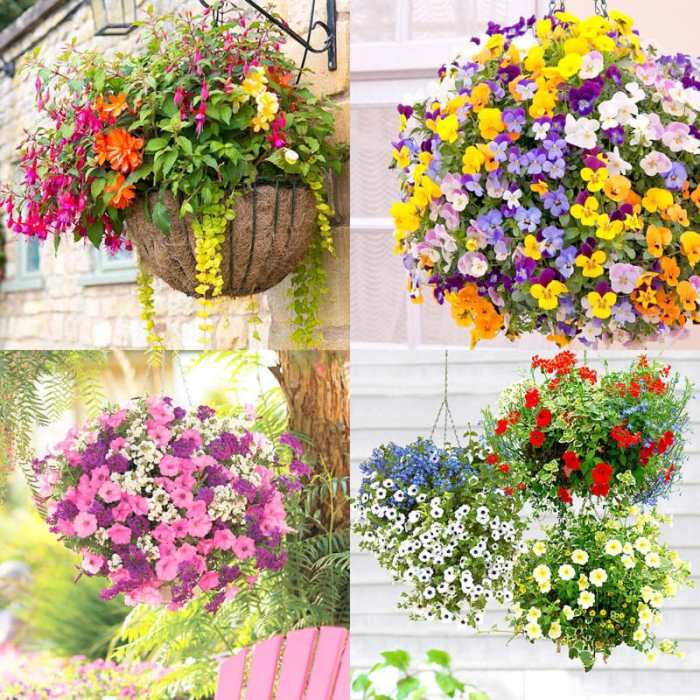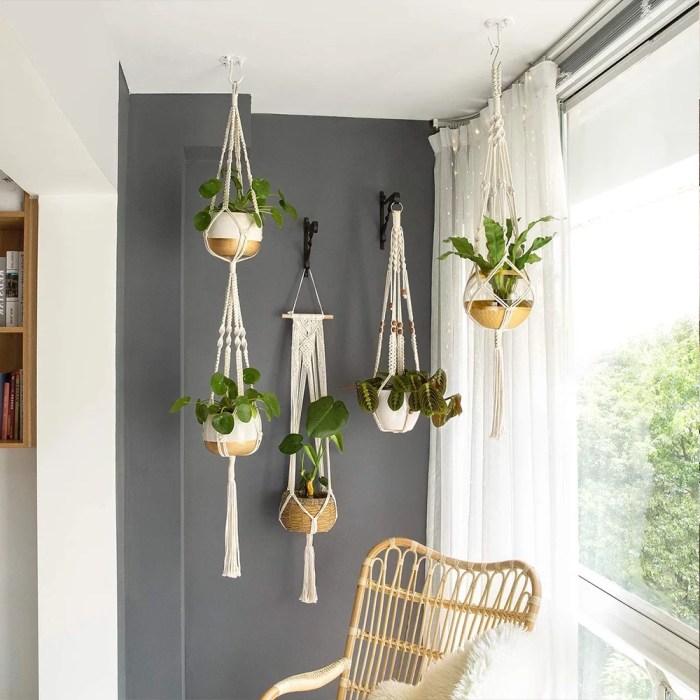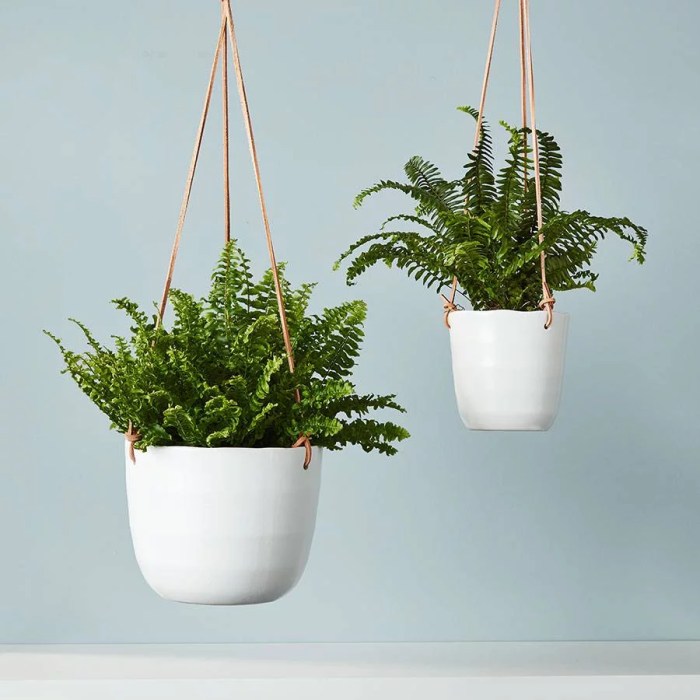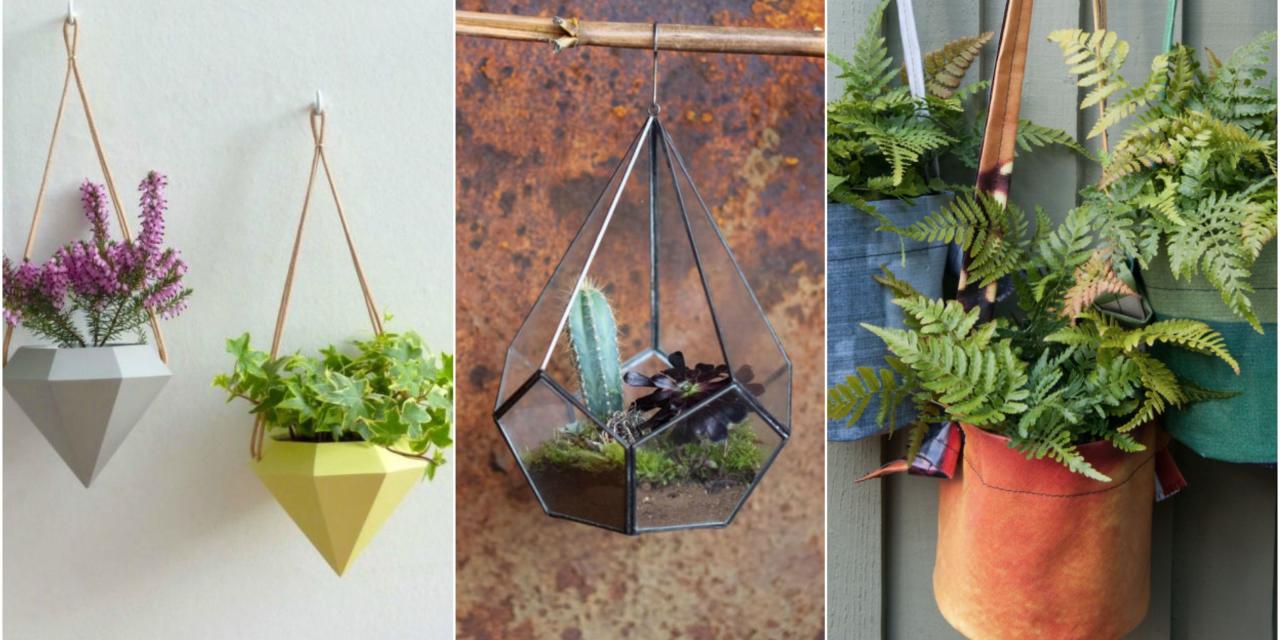Best plants for hanging planters indoors – Hanging planters are a fantastic way to add a touch of greenery and life to your indoor space. With the right plants, you can create a lush and inviting oasis that will improve your air quality and create a more serene and relaxing atmosphere.
In this guide, we’ll explore the best plants for hanging planters indoors, how to care for them, and how to create eye-catching arrangements that will transform your home.
When choosing plants for hanging planters, it’s important to consider the amount of light your space receives, the humidity levels, and the temperature. You’ll also want to choose plants that are relatively easy to care for and that won’t outgrow their planters too quickly.
Identifying the Most Suitable Plants for Hanging Planters Indoors

When selecting plants for hanging planters indoors, certain characteristics become essential for their success. These include adaptability to indoor conditions, manageable growth patterns, and visually appealing foliage or flowers. Several popular and aesthetically pleasing plants fulfill these criteria, making them ideal choices for this purpose.
Among the most suitable plants for hanging planters indoors are:
- Spider Plant (Chlorophytum comosum):With its graceful, arching leaves and easy-to-care-for nature, the spider plant is a popular choice. It tolerates a wide range of light conditions and produces plantlets that can be propagated to create new plants.
- Pothos (Epipremnum aureum):Known for its trailing vines and heart-shaped leaves, pothos is a low-maintenance plant that can thrive in both bright and low-light environments. Its variegated varieties add a splash of color to any indoor space.
- String of Pearls (Senecio rowleyanus):This unique succulent features delicate, bead-like foliage that cascades over the edges of hanging planters. It prefers bright, indirect light and well-draining soil.
- Trailing Jade (Crassula ovata ‘Hummel’s Sunset’):A miniature version of the popular jade plant, trailing jade has small, fleshy leaves with a reddish-orange tint. It requires bright light and infrequent watering.
- Air Plants (Tillandsia spp.):These fascinating plants absorb nutrients and moisture from the air, making them perfect for hanging planters. They come in various shapes and sizes, adding a touch of greenery without the need for soil.
Evaluating the Ideal Growing Conditions for Indoor Hanging Plants

Ensuring optimal growing conditions is crucial for the health and well-being of indoor hanging plants. These factors include providing adequate lighting, maintaining appropriate temperature and humidity levels, and establishing a suitable watering schedule.
Lighting Requirements
Most indoor hanging plants thrive in bright, indirect light. Avoid placing them in direct sunlight, as this can scorch their leaves. If natural light is limited, consider supplementing with artificial grow lights.
Temperature and Humidity
The ideal temperature range for indoor hanging plants is between 65-75°F (18-24°C). Extreme temperatures can damage their foliage and stunt their growth. Additionally, many hanging plants prefer higher humidity levels, which can be achieved by misting them regularly or using a humidifier.
Watering Frequency
Watering frequency depends on factors such as plant type, pot size, and environmental conditions. As a general rule, allow the soil to dry out slightly between waterings. Overwatering can lead to root rot, while underwatering can cause wilting and stunted growth.
Indoor hanging planters bring greenery and vibrancy to any space. For low-light areas, consider selecting from the best hanging low light plants . These resilient varieties thrive in indirect or filtered light, making them ideal for homes, offices, and other spaces with limited natural illumination.
By incorporating these low-maintenance plants into your hanging planters, you can enjoy the beauty of nature indoors, even in areas with limited sunlight.
Designing Eye-Catching Arrangements with Hanging Planters

Hanging planters offer a unique opportunity to create visually appealing displays that add life and greenery to indoor spaces. By combining different plant species, colors, and heights, you can achieve cohesive and harmonious arrangements that will become a focal point of your home decor.
Best plants for hanging planters indoors include pothos, spider plants, and ferns. These plants are easy to care for, making them ideal for beginners. For more information on the best indoor hanging plants for beginners, visit this website . Once you have chosen the right plants, you can enjoy the beauty of hanging planters indoors.
Combining Plant Species and Colors
When selecting plants for hanging planters, consider their size, shape, and growth habits. Combine trailing plants like ivy or pothos with upright plants like snake plants or succulents to create a dynamic display. Choose plants with contrasting colors and textures to add visual interest, such as pairing a variegated spider plant with a deep green philodendron.
Varying Heights and Lengths, Best plants for hanging planters indoors
Varying the heights and lengths of hanging planters adds depth and interest to the arrangement. Hang some planters high above the ground, while others can be placed closer to eye level. Use different lengths of chains or cords to create a staggered effect.
This will draw the eye upward and create a sense of movement.
Maintaining the Health and Vibrancy of Hanging Indoor Plants

To maintain the health and vibrancy of hanging indoor plants, regular care and maintenance are crucial. This includes proper watering, providing adequate sunlight, and ensuring the right temperature and humidity levels. Additionally, pruning, pest and disease control, and fertilization play vital roles in keeping these plants thriving.
Pruning and Trimming
Pruning and trimming are essential for maintaining the shape and size of hanging plants. Regular removal of dead, diseased, or overgrown stems and leaves promotes healthy growth and prevents the plant from becoming leggy or misshapen. Pruning also encourages the growth of new shoots and foliage, resulting in a fuller and more attractive plant.
Pest and Disease Control
Indoor hanging plants can be susceptible to various pests and diseases. It is important to regularly inspect plants for signs of infestation or infection. Common pests include aphids, mealybugs, spider mites, and whiteflies. These pests can be controlled using insecticidal soap or neem oil.
Fungal diseases, such as powdery mildew and botrytis, can be treated with fungicides. Early detection and treatment are crucial for preventing the spread of pests and diseases.
Fertilization
Fertilization is essential for providing hanging plants with the nutrients they need for healthy growth. A balanced liquid fertilizer should be applied regularly, following the manufacturer’s instructions. Fertilizing promotes lush foliage, vibrant blooms, and overall plant health. However, over-fertilization can lead to nutrient burn and damage the plant.
It is important to avoid using fertilizers with high levels of nitrogen, as this can encourage excessive foliage growth at the expense of flowering.
Creating a Unique Indoor Oasis with Hanging Planters
Hanging planters have become an increasingly popular way to bring the beauty of nature indoors. They offer a unique way to display plants, create a lush and inviting atmosphere, and even improve air quality. Whether you’re looking to add a touch of greenery to a small apartment or create a sprawling indoor jungle, hanging planters can help you achieve your desired look.
One of the great things about hanging planters is that they can be used in a variety of ways. They can be hung from the ceiling, walls, or even from furniture. This makes them a versatile option for any room in your home.
Hanging planters can also be used to create different looks, from a simple and understated accent to a dramatic and eye-catching centerpiece.
To enhance the ambiance of indoor spaces, hanging planters filled with lush greenery offer a captivating solution. Whether seeking to adorn living areas or create a serene atmosphere in bedrooms, the selection of appropriate plants is crucial. For those seeking inspiration for their hanging planters, a comprehensive guide to bedroom plants hanging provides valuable insights into the best choices for both aesthetics and air purification.
In addition to their aesthetic appeal, hanging planters also offer a number of practical benefits. They can help to improve air quality by removing toxins from the air. Plants release oxygen and water vapor into the air, which can help to improve your breathing and overall health.
Hanging planters can also help to reduce stress and create a more relaxing atmosphere. The sight and smell of plants can help to calm the mind and body.
Incorporating Hanging Planters into Different Room Designs and Styles
Hanging planters can be used to complement any room design or style. In a modern space, hanging planters with clean lines and simple designs can add a touch of sophistication. In a more traditional space, hanging planters with ornate details can add a touch of elegance.
And in a bohemian space, hanging planters with macrame or woven materials can add a touch of whimsy.
No matter what your style, there are sure to be hanging planters that will fit your needs. With so many different options to choose from, you’re sure to find the perfect way to add a touch of greenery to your home.
Hanging Planters for Improved Air Quality and Serene Atmosphere
In addition to their aesthetic appeal, hanging planters also offer a number of practical benefits. They can help to improve air quality by removing toxins from the air. Plants release oxygen and water vapor into the air, which can help to improve your breathing and overall health.
Hanging planters can also help to reduce stress and create a more relaxing atmosphere. The sight and smell of plants can help to calm the mind and body.
Studies have shown that exposure to plants can reduce stress, improve mood, and boost creativity. Plants can also help to reduce noise levels and create a more comfortable environment. If you’re looking for a way to improve your indoor air quality and create a more relaxing atmosphere, hanging planters are a great option.
Last Point: Best Plants For Hanging Planters Indoors

With a little care and attention, your hanging planters will thrive and bring beauty and freshness to your indoor space. So get creative and experiment with different plants and arrangements to create a unique and inviting indoor oasis.
Commonly Asked Questions
What are the best plants for hanging planters indoors?
Some of the best plants for hanging planters indoors include pothos, spider plants, ferns, and succulents.
How often should I water my hanging plants?
The frequency of watering will depend on the type of plant, the size of the planter, and the humidity levels in your home. A good rule of thumb is to water your plants when the soil feels dry to the touch.
How can I create a visually appealing arrangement with my hanging planters?
When creating an arrangement with your hanging planters, consider the height, length, and color of the plants. You can also vary the size and shape of the planters to add interest. Experiment with different combinations until you find an arrangement that you love.